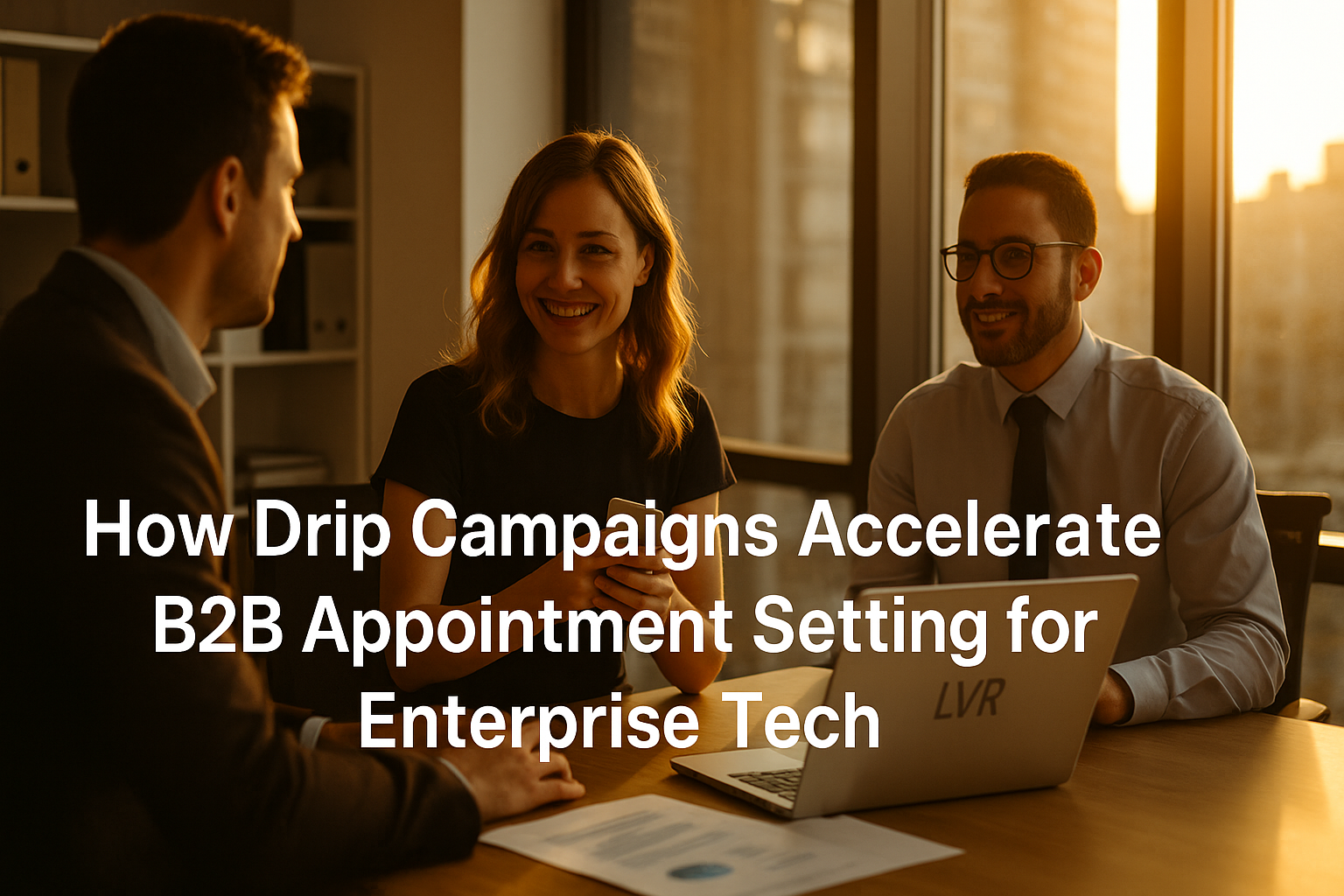How Enterprise Tech Companies Use B2B Appointment Setting to Win More Deals
B2B Appointment Setting
Explore how modern drip campaigns help enterprise tech marketers sustain engagement, nurture intent, and convert prospects into qualified meetings.
-
Demand Generation Strategy

Introduction
In enterprise technology marketing, the path from initial engagement to a booked meeting isn’t always linear. Prospects often take weeks—or even months—to reach a decision point. That’s where drip campaigns come in. By delivering consistent, relevant touchpoints over time, drip campaigns help enterprise marketers stay top-of-mind, nurture intent, and ultimately accelerate appointment setting outcomes.
For demand generation teams, mastering the art of drip engagement can be the difference between stalled pipelines and predictable meeting flow.
What Drip Campaigns Mean for Demand Generation Marketers
A drip campaign is a series of automated, targeted communications—often email or SMS—that guide prospects through the buyer journey based on their behavior or engagement level.
In enterprise tech, drip campaigns are especially valuable because the sales cycle involves multiple stakeholders, complex solutions, and longer decision timelines. Rather than relying on one-off campaigns, drip sequences help marketers keep prospects engaged across weeks or months.
By nurturing intent consistently, marketers can identify the right time for outreach—turning passive interest into active meetings with qualified prospects.
Common Challenges Marketers Face
Even with automation tools in place, most enterprise tech marketers struggle to make drip campaigns effective.
These issues can leave even the most well-intentioned drip campaigns underperforming—and prevent teams from realizing their full appointment-setting potential.



.png)



.png)
%201.png)


.png)
%201.png)


.png)








Solutions That Work
To make drip campaigns an engine for appointment generation, enterprise marketers must evolve from basic automation to precision engagement. Here’s how leading teams are driving results:
Personalized Nurture Tracks: Instead of one-size-fits-all campaigns, create segmented drip sequences for each persona (e.g., IT Director, CIO, or Procurement Leader). Tailor value messaging to their role and decision influence.
Engagement-Based Triggers: Move beyond scheduled sends. Use behavioral signals—such as content downloads, website visits, or webinar sign-ups—to automatically adjust messaging cadence and outreach priority.
Integrated Data Workflows: Connect drip campaign platforms with your CRM and lead scoring systems to ensure qualified leads are surfaced to sales at the right time.
Consistent Messaging Across Channels: Combine email, SMS, and call touchpoints to keep your brand consistent across all communication mediums, increasing trust and response rates.
When done right, drip campaigns don’t just “warm up” leads—they create predictable meeting flow that shortens the path from interest to engagement.
Actionable Steps for Marketers
To turn drip campaigns into a reliable source of meetings, enterprise marketers can:
These refinements help marketing teams ensure that no prospect goes cold and that every nurtured lead has a clear next step toward a booked meeting.
Comparison of Market Solutions
Many enterprise marketers rely on in-house automation tools or outsourced appointment-setting vendors. In-house approaches often lack the scale, data precision, and follow-up consistency needed for enterprise pipelines. Meanwhile, outsourced teams vary in quality and transparency.
Modern demand generation success depends on integrated, data-driven engagement—where marketing automation, behavioral analytics, and human outreach combine to sustain pipeline momentum.
That’s where performance-based engagement models stand out—because they focus on meetings that actually happen, not just contacts in a sequence.
Conclusion
Drip campaigns have evolved from a simple automation tool into a vital part of enterprise demand generation strategy. When used strategically, they bridge the gap between awareness and action—transforming cold leads into qualified, ready-to-meet prospects.
To learn how your team can build a more consistent and measurable meeting pipeline, start a pilot with Site Ascend and see how precision engagement drives real outcomes for enterprise tech marketing.
How long should a typical B2B drip campaign run?
The most effective drip campaigns for enterprise tech often run 6–12 weeks, with multiple touchpoints aligned to different buying stages.
Should drip campaigns include sales outreach?
Yes—strategic sales follow-ups can be layered into drip sequences once engagement metrics indicate buying intent, ensuring a smoother transition from marketing to meeting.
What metrics best measure drip campaign success?
Look beyond open and click rates. Focus on conversion to booked meetings, time-to-engagement, and lead velocity to gauge real impact on pipeline health.



Start your pilot campaign today and explore the full range of Site Ascend's demand generation capabilities. Experience firsthand how we can enhance your efficiency, streamline your processes, and drive growth.
RELATED